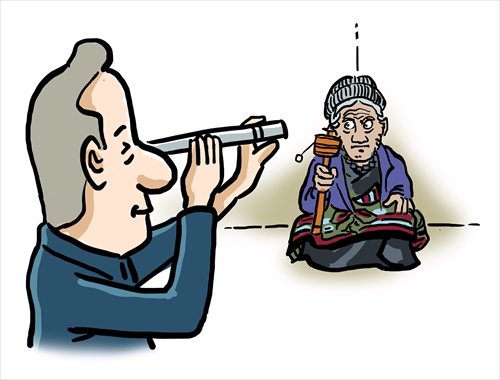Reality of Tibet defies media stereotypes

Illustration: Liu Rui/GT
I now belong to the privileged Westerners who have gained firsthand and original experience as far as the situation in Tibet is concerned. This invaluable knowledge allows me to shape my own position and judge the accuracy of Western bibliography on the matter.
Before my recent trip to Tibet, I had attempted to conduct some research on the autonomous region, relying heavily on available Western sources.
Their content is highly negative as well as one-dimensional. In particular, Tibet is portrayed as an almost dangerous place where Tibetans are arguably suffering from being deprived from basic human rights.
It is also illustrated as a miserable location in which self-immolation incidents of local citizens allegedly demonstrate the cruel and aggressive character of the central government.
All in all, the coverage is almost exclusively based on the arguments by the 14th Dalai Lama.
Nonetheless, my own conclusion is rather different from the Western coverage and interpretation of Tibet.
From the moment I landed in the airport of Lhasa until I was about to return, I was continuously noticing that the autonomous region benefits from a positive dimension indeed. Its modernization certainly mirrors that of the whole country.
Living standards of Tibetans, for instance, have improved in recent years as the impressive increase of the Gross Regional Product highlights.
Additionally, modernized education pays attention to the preservation of the Tibetan culture, while women's rights to education and employment are remarkably safeguarded.
Further to this, various solutions are under consideration to guarantee the sustainable development of bilingual education in Tibetan areas.
In parallel with the aforementioned achievements, a visitor to the Tibet plateau can easily realize the importance attributed to the autonomous region by the central government. The new highway which connects the airport of Lhasa to the city is a characteristic example.
Moreover, various railways works linking together some towns of Tibet have been already completed and can be used by local citizens and tourists.
Generally speaking, the first impression of an international visitor of Tibet is that the region is under the process of a construction boom as new highways, railway networks, buildings and hotels will be ready for usage in coming years.
It is important that visiting Tibet gave me the chance to talk to ordinary citizens in person and discover their level of satisfaction with the situation.
There is perhaps no better evidence for an objective assessment than the happy faces of young couples who were walking in squares and streets enjoying life.
Many were keen on taking photos and immediately uploading them on social networks such as WeChat and Weibo.
Coming back from Tibet, I can at least say that the region has been rather misunderstood in the West. Stereotypes frequently reproduced in the media discourse reflect traditional suspicion of a rising China.
Of course, as it happens with other regions of the world, more needs to be done in Tibet, so as to further improve living standards and attract additional tourists. But the progress achieved so far is significant and promising for the future.
If there is a main hurdle China has to overcome in order to promote the autonomous region to the world, this is related to its marketing strategy.
As long as some Western media will start to follow a more balanced approach in covering the autonomous region, the road for the spread of knowledge of its harmonious development will be open. Communication matters almost equally with progress achieved.
The author is a research fellow at the Hellenic Foundation for European and Foreign Policy. opinion@globaltimes.com.cn